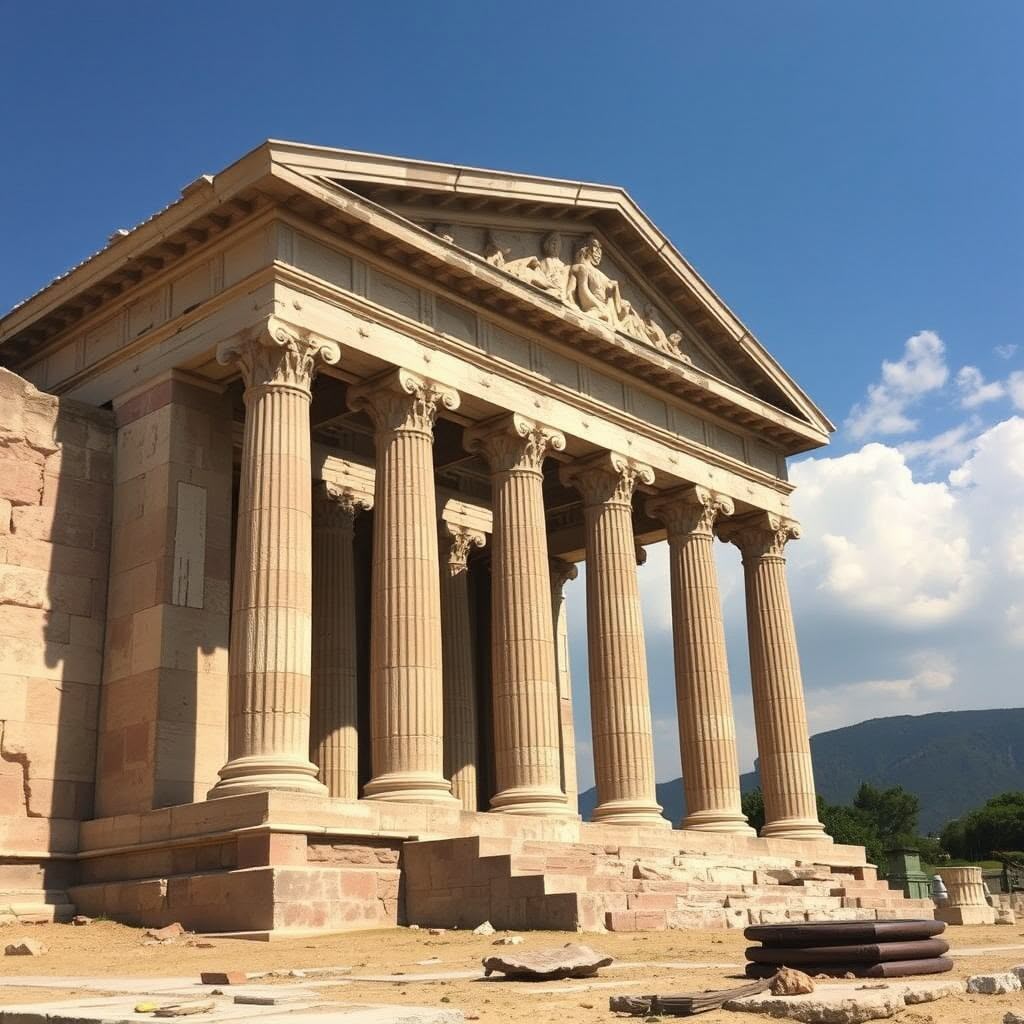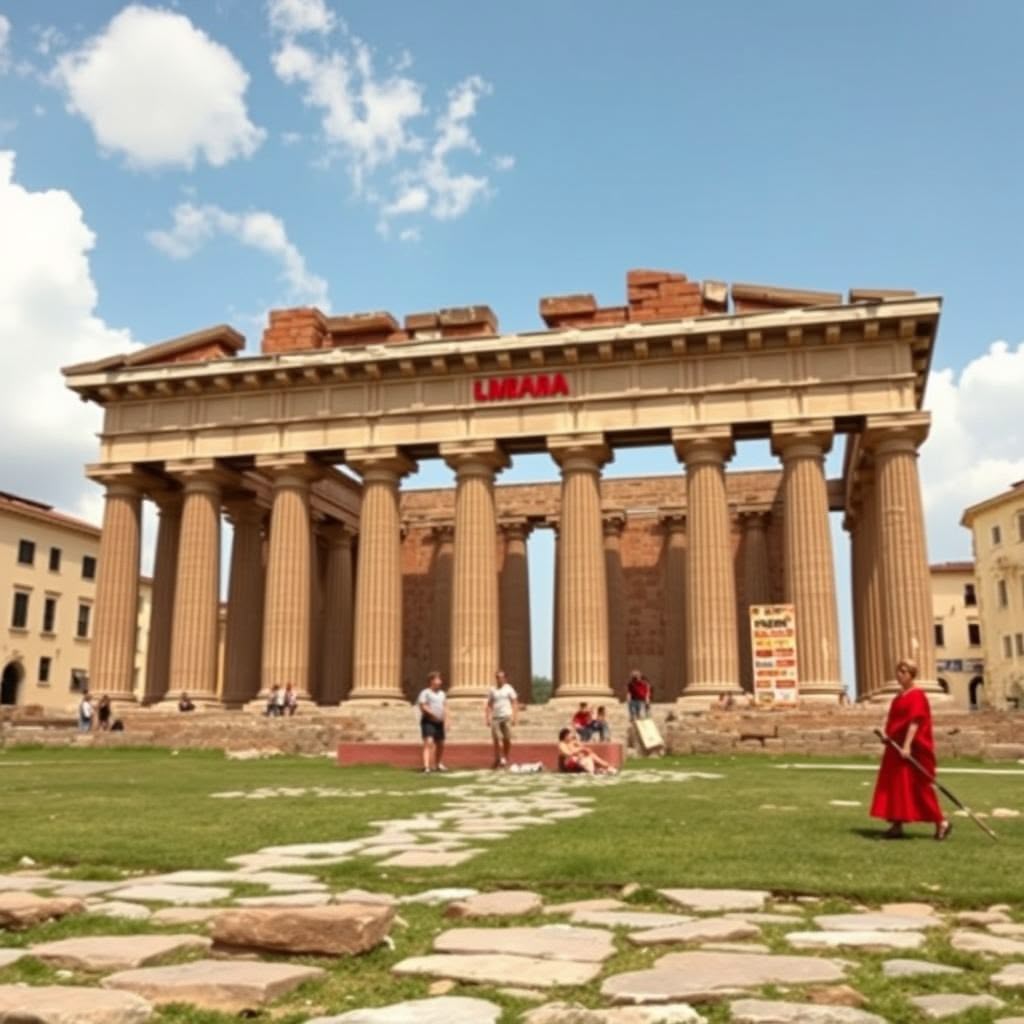When a judge bangs the gavel in an American courtroom, few realize they’re witnessing the echo of a two-thousand-year-old Roman tradition. The judge, the jury, the very concept of evidence—these cornerstones of modern justice weren’t invented in Philadelphia in 1776 or in London’s Parliament. They were forged in the Forum of ancient Rome.
Last month, when Florida homeowner Marcus Jennings successfully sued a developer who had encroached on his property line, he wasn’t just exercising his constitutional rights—he was wielding legal principles first codified when Rome ruled the Mediterranean. The developer had to restore Jennings’ boundary and pay damages, following reasoning that would have been perfectly comprehensible to a Roman praetor in 100 BCE.
We live under the invisible protection of Roman law every day. When you sign a contract, close on a house, challenge an unfair detention, or expect compensation for damages, you’re benefiting from legal innovations pioneered by toga-wearing lawmakers millennia ago. Before Rome’s systematic approach to justice, legal proceedings were often arbitrary, inconsistent, and heavily favored the powerful. Roman jurisprudence changed that trajectory forever.
What makes this ancient legal system so remarkable isn’t just its sophistication, but its staying power. The Romans created something so fundamentally sound that it survived the collapse of their empire, the Dark Ages, the Renaissance, the Industrial Revolution, and the Digital Age to remain at the heart of Western legal tradition.
This isn’t merely academic history—it’s the story of how your most basic rights were established and why they continue to protect you today. Let’s explore five crucial Roman legal principles that silently guard your rights in the modern world, shaping everything from your property boundaries to your day in court.

Habeas Corpus: Rome’s Gift of Personal Liberty
When Jennifer Wilson was wrongfully detained by police in Chicago in 2019 after being mistaken for another woman with a similar name and appearance, her attorney immediately filed a habeas corpus petition. Within hours, a judge ordered authorities to either present legitimate charges or release her. Wilson walked free that afternoon.
The phrase “habeas corpus”—Latin for “you shall have the body”—sounds arcane to modern ears, but it represents one of the most powerful protections against government overreach ever devised. This fundamental safeguard against arbitrary detention has its roots in ancient Rome’s concept of ius provocatio, the right of a Roman citizen to appeal to higher authorities when detained.
Before Rome developed these protections, rulers throughout the ancient world could imprison subjects indefinitely without justification. Roman citizenship, however, conferred the revolutionary right to contest one’s detention. As Roman statesman Cicero proclaimed: “To bind a Roman citizen is a crime, to flog him is an abomination, to kill him is almost an act of murder.”
While the formal writ of habeas corpus emerged in medieval England, its philosophical foundation was laid in Roman law. The principle that governing authorities must justify detention before an independent judicial body represented a profound limitation on state power. This concept survived Rome’s fall, was expanded in medieval England, and eventually became enshrined in constitutions worldwide.
Today, habeas corpus petitions remain vital tools against unlawful detention. In the United States alone, federal courts receive approximately 20,000 habeas petitions annually. Each one represents the living legacy of a principle first recognized when Rome ruled the known world.
As legal historian Sarah McKinnon notes: “The Roman innovation was recognizing that legitimate authority requires limitations and oversight. Their concept that even powerful officials must justify their actions before independent authorities when restricting liberty remains the cornerstone of modern civil rights.”

Pacta Sunt Servanda: The Roman Foundation of Contract Law
When Alicia Rodriguez signed a freelance contract with a major corporation last year, she had no idea that the enforceability of that agreement traced back to ancient Rome. When the company later attempted to change payment terms unilaterally, Rodriguez prevailed in court by invoking principles first established in the Roman Forum.
The Roman principle of pacta sunt servanda—”agreements must be kept”—revolutionized human commerce by establishing that contracts create legally binding obligations. This concept may seem obvious today, but before Rome, contractual agreements largely depended on personal honor, family connections, or religious oaths rather than systematic legal enforcement.
Roman jurists developed sophisticated frameworks for validating agreements, determining when contracts were binding, and establishing remedies for breach. They recognized different categories of contracts—verbal, written, and those created by conduct—with specific rules governing each type. This systematic approach transformed commercial relationships by providing predictability and enforceability.
“Before Roman contract law, commercial transactions beyond immediate family or tribal connections carried enormous risk,” explains Professor James Harrington of Columbia Law School. “Rome’s innovation was creating a system where strangers could reliably transact business across vast distances with confidence that agreements would be honored—or consequences would follow.”
Rome’s contract principles survived its empire’s collapse because they answered essential human needs for commercial certainty. Medieval merchants preserved these concepts, and by the Renaissance, Roman contract principles had been incorporated into the emerging legal systems of European nations. During colonial expansion, these same principles spread globally.
Today’s contract law still reflects its Roman origins. The requirements for valid contracts—offer, acceptance, consideration, capacity, and legality—evolved directly from Roman formulations. When courts determine whether contracts are valid or what remedies apply for breach, they follow reasoning patterns established by Roman jurists.
Every time you sign a lease, accept a job offer, or make a major purchase, you’re participating in a legal tradition stretching back to the Roman Republic. The next time a business honors its warranty or a court enforces a written agreement, remember that you’re witnessing the modern application of Roman legal wisdom.
Dominium: The Sacred Right of Property Ownership
When Thomas Reynolds discovered that a neighbor had built a fence encroaching two feet onto his property in suburban Dallas, his legal recourse rested on concepts first defined by Roman property law. The court ordered the fence removed and the boundary restored based on principles of ownership that would have been immediately recognizable to a Roman citizen.
The Roman concept of dominium established a sophisticated understanding of property rights that continues to shape modern legal systems. Roman law recognized that ownership conferred specific powers: the right to use property (usus), the right to its fruits or profits (fructus), and the right to consume or transfer it (abusus). This tripartite division still underpins property rights worldwide.
Before Rome’s systematic approach, property disputes were often settled through force or arbitrary rulings. Roman innovation lay in creating predictable legal frameworks for determining rightful ownership, resolving boundary disputes, and transferring property through inheritance or sale. Their sophisticated property registry system—the census—provided early versions of today’s property records.
Perhaps most significant was the Roman concept that property rights existed independent of physical possession. If someone wrongfully took your property, Roman law recognized you still retained rightful ownership—a revolutionary concept that protected against theft and fraud.
“Roman property law transformed the relationship between people and possessions,” notes legal historian Marcus Chen. “By establishing clear rules for acquisition, transfer, and protection of property, Rome created the conditions for economic development that would have been impossible in systems where possession was determined primarily by force.”
Roman property concepts survived through Justinian’s Code in the Byzantine Empire, were studied in medieval universities, and gradually incorporated into emerging European legal systems. These principles crossed the Atlantic with colonial expansion, forming the foundation of American and Canadian property law.
Today, when you record a deed, object to trespassing, or expect compensation for property damage, you’re invoking legal principles with direct Roman ancestry. Property rights we take for granted—that boundaries must be respected, that ownership can be transferred through proper documentation, that unauthorized use deserves compensation—all have Roman origins.
Modern adaptations like homeowners associations, zoning laws, and environmental regulations have modified traditional property rights, but the core Roman principle remains: legitimate ownership confers legally protected rights that others must respect. Two thousand years later, dominium continues to protect what’s yours.

Stare Decisis: The Power of Legal Precedent
When the Supreme Court cited previous cases in its landmark 2015 decision on marriage equality, it was employing a principle with distinct Roman origins. The concept that similar cases should be decided similarly—known today as stare decisis or legal precedent—traces back to Roman judicial practice.
Roman praetors, the officials responsible for administering justice, published annual edicts outlining how they would decide various types of cases. Over time, these edicts created a body of consistent rulings that judges were expected to follow. This approach marked a revolutionary shift from arbitrary decision-making toward predictable application of legal principles.
Before this Roman innovation, legal outcomes often depended entirely on who happened to be judging a case and what mood they were in that day. By establishing that similar situations deserved similar treatment, Roman jurisprudence introduced fundamental fairness into legal proceedings. Citizens gained the ability to predict legal outcomes based on previous decisions.
“The Roman contribution wasn’t just creating laws but developing a method for applying them consistently,” explains Professor Elena Ramirez of Harvard Law School. “Their insight that justice requires treating like cases alike remains fundamental to legitimate legal systems worldwide.”
This principle survived Rome’s fall through collections of Roman law like Justinian’s Digest, which preserved the reasoning of great Roman jurists. Medieval legal scholars studied these compilations, gradually incorporating precedent-based reasoning into European legal systems. The concept reached its fullest development in English common law, which systematized case precedent as a binding source of law.
Today, when your attorney researches previous court decisions to support your case, they’re employing a method with clear Roman ancestry. Every time a judge considers how similar situations were handled in the past, they’re participating in a tradition that stretches back to the Roman Forum.
The modern doctrine of precedent has evolved significantly—with formal hierarchies of courts and explicit rules about when precedents can be overturned—but the core Roman insight remains: legal systems gain legitimacy when they decide similar cases similarly. This principle protects against arbitrary rulings and ensures that your legal rights don’t depend simply on which judge happens to hear your case.

Legal Remedies: Making the Injured Whole Again
When Michael Thompson received compensation after a delivery truck damaged his car last year, the legal principle behind his recovery had Roman origins. The fundamental concept that wrongdoers should compensate those they harm—making victims “whole” again—was systematically developed in Roman law through the concept of delict.
Rome’s sophisticated approach to remedies revolutionized how societies addressed wrongs between citizens. Before Rome, injuries were often addressed through blood feuds or rigid systems of fixed penalties regardless of actual harm. Roman innovation lay in developing proportional, compensatory remedies that matched the specific injury suffered.
The Romans recognized different categories of civil wrongs requiring different remedies. Physical injury (iniuria), property damage (damnum iniuria datum), theft (furtum), and fraud (dolus) each had specific rules for determining compensation. This nuanced approach aimed to restore victims to their position before the harm occurred—a concept still central to modern tort law.
“Roman remedies were remarkably sophisticated,” notes legal historian Patricia Johnson. “They understood the difference between compensating actual damages and punishing wrongful conduct. This distinction between civil remedies and criminal punishment remains fundamental to modern legal systems.”
Roman concepts of legal remedy survived through medieval legal codes and were systematically incorporated into emerging European civil law systems. When English common law developed its approach to torts and damages, it drew heavily on these Roman principles.
Today, when you receive compensation for a car accident, breach of contract, or property damage, you’re benefiting from a remedial framework with clear Roman ancestry. The principle that wrongdoers should bear the cost of harm they cause—rather than victims absorbing losses—continues to guide modern civil justice.
The Roman approach to remedies wasn’t limited to monetary compensation. They also developed injunctions (interdictum) to prevent threatened harm and specific performance to enforce contractual obligations. These varied remedial tools gave courts flexibility to address different situations appropriately—an approach modern courts still follow.
Every time a court awards damages, orders specific performance of a contract, or issues an injunction against harmful conduct, it’s applying remedial principles first systematized by Roman jurists. This sophisticated approach to making victims whole remains one of Rome’s most enduring legal legacies.
The Bridge from Ancient Rome to Modern Rights
The path from Roman legal concepts to modern rights protections wasn’t straightforward. Rome’s fall initially threatened these sophisticated legal frameworks, but Justinian’s monumental compilation of Roman law in the 6th century CE preserved these principles for future generations.
Medieval universities began studying Roman law intensively during the 12th century, spreading these concepts throughout Europe. As nation-states developed their own legal codes, they incorporated Roman principles that had proven their value over centuries. European colonization then carried these legal traditions globally.
The American legal system, despite its common law foundation, draws heavily on Roman concepts. Thomas Jefferson studied Roman law extensively, and its influence is evident throughout early American legal development. Civil law jurisdictions like Louisiana, Quebec, and most of continental Europe maintain even stronger connections to their Roman legal heritage.
What makes these ancient principles so enduring isn’t their age but their effectiveness. They’ve survived because they address fundamental human needs for fairness, predictability, and proportional justice. As societies have evolved, these principles have been adapted rather than abandoned.
“Roman law endures because it’s pragmatic,” observes Supreme Court Justice Elena Kagan. “It recognized the practical realities of human interaction and developed workable solutions to universal problems. Modern courts continue finding wisdom in these ancient principles.”
The next time you sign a contract, record a property deed, challenge unfair treatment, or seek compensation for harm, remember that you’re exercising rights with roots in the Roman Forum. Your most fundamental legal protections weren’t invented recently—they’ve been refined over millennia.
Perhaps most remarkable is how these principles transcend political systems. From republics to monarchies, democracies to authoritarian states, these Roman concepts have proven adaptable to different governmental forms while consistently protecting individual rights.
As we face new legal challenges in the digital age—from data privacy to intellectual property in the information economy—Roman principles continue offering guidance. Their flexible, principle-based approach provides a framework for addressing novel situations while maintaining fundamental fairness.
The Roman legal legacy reminds us that effective rights protection doesn’t depend on political fashion or temporary majorities but on enduring principles of justice that have withstood history’s greatest tests. In a world of rapid change, there’s profound reassurance in legal foundations that have protected rights for over two thousand years—and continue protecting yours today.
The Roman Legal Inheritance: Protecting Your Rights in Tomorrow’s World
As we navigate complex 21st-century challenges, from artificial intelligence to climate change, these ancient principles continue providing guidance. Roman law’s remarkable adaptability—its ability to apply consistent principles to entirely new circumstances—makes it as relevant today as when it was first developed.
The next time you benefit from due process, property protection, contract enforcement, consistent judicial reasoning, or appropriate remedies for harm, take a moment to appreciate their Roman origins. These weren’t rights granted by recent legislation or modern constitutions but principles distilled from millennia of human experience with justice.
In a time of political polarization and institutional challenges, there’s profound reassurance in recognizing that our most fundamental legal protections have already survived the collapse of empires, revolutionary upheavals, and technological transformations. The Roman legal inheritance represents not just history but humanity’s most durable insights into establishing justice between individuals.
As Marcus Tullius Cicero, Rome’s greatest lawyer, observed over two thousand years ago: “True law is right reason in agreement with nature. It is of universal application, unchanging and everlasting.” In our rapidly changing world, Roman legal wisdom continues lighting the path toward justice—just as it has for more than two millennia.

